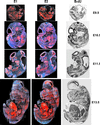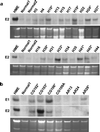Expression of cyclins E1 and E2 during mouse development and in neoplasia
- PMID: 11687642
- PMCID: PMC60837
- DOI: 10.1073/pnas.231487798
Expression of cyclins E1 and E2 during mouse development and in neoplasia
Abstract
Cyclin E1 (formerly called cyclin E) and the recently described cyclin E2 belong to the family of E-type cyclins that operate during the G(1)/S phase progression in mammalian cells. The two E-cyclins share a catalytic partner, cyclin-dependent kinase 2 (CDK2), and activate their associated kinase activities at similar times during cell cycle progression. Despite these similarities, it is unknown whether the two proteins perform distinct functions, or, alternatively, they control S-phase entry of different cell types in a tissue-specific fashion. To start addressing in vivo functions of E-cyclins, we determined the expression pattern of cyclins E1 and E2 during normal mouse development. We found that the two E-cyclins showed very similar patterns of expression; both were expressed within the proliferating compartment during embryo development. Analyses of cells and tissues lacking members of the retinoblastoma (pRB) family of proteins revealed that the expression of both cyclins is controlled in a pRB-dependent, but p107- and p130-independent fashion, likely through the pRB-dependent E2F transcription factors. We also found that cyclins E1 and E2 are expressed at high levels in mouse breast tumors driven by the Myc oncogene. Last, we found that cyclin E2 is overexpressed in approximately 24% of analyzed human mammary carcinomas. Collectively these findings suggest that the expression of cyclins E1 and E2 is governed by similar molecular circuitry.
Figures





References
-
- Sherr C J, Roberts J M. Genes Dev. 1999;13:1501–1512. - PubMed
-
- Sicinski P, Donaher J L, Parker S B, Li T, Fazeli A, Gardner H, Haslam S Z, Bronson R T, Elledge S J, Weinberg R A. Cell. 1995;82:621–630. - PubMed
-
- Sicinski P, Donaher J L, Geng Y, Parker S B, Gardner H, Park M Y, Robker R L, Richards J S, McGinnis L K, Biggers J D, et al. Nature (London) 1996;384:470–474. - PubMed
-
- Tam S W, Theodoras A M, Shay J W, Draetta G F, Pagano M. Oncogene. 1994;9:2663–2674. - PubMed
-
- Albanese C, Johnson J, Watanabe G, Eklund N, Vu D, Arnold A, Pestell R G. J Biol Chem. 1995;270:23589–23597. - PubMed
Publication types
MeSH terms
Substances
Grants and funding
LinkOut - more resources
Full Text Sources
Other Literature Sources
Medical
Molecular Biology Databases

